Johannine Studies Collection, 10 vols. (Library of New Testament Studies | LNTS / JSNTS)
Digital Logos Edition
Overview
The T&T Clark Johannine Studies Collection represents some of the most cutting-edge research and newest insights in the study of the Johannine literature. Using advanced research methods in linguistics and exegesis, these volumes offer in-depth analysis on important passages, theological interpretation of significant texts and themes, and a window into the world of the New Testament—one through which we can better understand the context and message of Scripture.
These important studies bring clarity to highly debated passages and theological themes such as the eschatological “hour” of the Gospel of John, what it meant in the Old Testament and the prophecies of Daniel, and how Jesus appropriates those Old Testament meanings in his teaching. In The Fourth Gospel in First-Century Media Culture, editors Anthony Le Donne and Tom Thatcher bring together a team of experts to discuss the writing and reception of John in first-century media culture. Other volumes use rhetorical analysis to explore John’s use of the Old Testament and provide thorough treatments of various motifs in the book of Revelation.
The Logos Bible Software editions of these volumes streamline and enhance your study of the Johannine literature. Scripture passages link directly to English translations and original-language texts, and important theological and hermeneutical concepts link to dictionaries, encyclopedias, and a wealth of other resources in your digital library. In addition, you can perform powerful searches by topic and find what other authors, scholars, and theologians have to say about things like intertextuality in John, orality in the first century, and Johannine eschatology.
About the Series
The Library of New Testament Studies is a premier book series that offers modern research for scholars, NT teachers, postgraduate students, and advanced undergraduates. The series was launched by Sheffield Academic Press in 1981 to complement its associated journal, the Journal for the Study of the New Testament. The series pursues all aspects of New Testament study, including innovative work from historical perspectives, studies using social-scientific and literary theory, and theological, cultural, and contextual approaches.
For more T&T Clark volumes from the Library of New Testament Studies, be sure to also check out the T&T Clark Pauline Studies Collection (28 vols.), the T&T Clark General Epistles Collection (15 vols.), and the T&T Clark Studies in the Gospels and Acts (18 vols.).

Key Features
- Recent developments in Johannine studies
- In-depth academic treatment of significant texts and themes in Johannine literature
Individual Titles
- The Danielic Eschatological Hour in the Johannine Literature by Stefanos Mihalios
- The Fourth Gospel in First-Century Media Culture edited by Anthony Le Donne and Tom Thatcher
- Characterizing Jesus: A Rhetorical Analysis on the Fourth Gospel’s Use of Scripture in its Presentation of Jesus by Alicia D. Myers
- Characters and Characterization in the Gospel of John edited by Christopher W. Skinner
- Thomas - Love as Strong as Death: Faith and Commitment in the Fourth Gospel by Dennis Sylva
- The Conversion of the Nations in Revelation by Allan J. McNicol
- The Throne Motif in the Book of Revelation by Laszlo Gallusz
- Here Comes the Judge: Violent Pacifism in the Book of Revelation by Matthew Streett
- Hearing at the Boundaries of Vision: Education Informing Cosmology in Revelation 9 by Sean Michael Ryan
- Thinking and Seeing with Women in Revelation by Lynn R. Huber
This title is included in the following collections
You can save when you purchase this product as part of a collection.
2025 Researcher Portfolio Libr...
$4,749.99$3,562.492025 아카데믹 포트폴리오 서재
$4,899.99$3,674.99Verbum 9 Portfolio Legacy Libr...
$4,749.99$4,749.99Verbum 9 Ultimate Legacy Libra...
$7,749.99$7,749.99
- $23,999.99$17,999.99
- $24,999.99
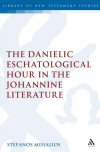
Stefanos Mihalios examines the uses of “the hour” in the writings of John and demonstrates the contribution of Danielic eschatology to John’s understanding of this concept. Mihalios begins by tracing the notion of an eschatological time in the Old Testament within expressions such as “in that time” and “time of distress” which appear in the book of Daniel and relate to the Danielic eschatological hour. Mihalios finds that even within the Jewish tradition there exists an anticipation of the fulfillment of the Danielic eschatological time since the eschatological hour appears in the Jewish literature within contexts that allude to the Danielic end-time events. Mihalios then examines the Johannine eschatological expressions and themes that have their source in Daniel, finding evidence of clear allusions whenever the word “hour” arises. Through this examination, he concludes that, for the Johannine Jesus, use of the term “hour” indicates that the final hour of tribulation and resurrection, as it is depicted in Daniel, has arrived.
This book is an important contribution to the study of the Hebrew Bible background to the Gospel of John . . . Overall, the book is well organized and well written, fluid and lucid in style, and persuasive in argument. It is a helpful and illuminating study that contributes well to our understanding of the Hebrew Bible background of the Fourth Gospel, elucidating the particular emphases of Johannine eschatology.
—Religious Studies Review
The careful work on the influence of the Danielic eschatological hour forms the core of this book and is valuable . . .
—John Painter, professor of theology, St. Mark’s School of Theology, Charles Sturt University, Australia
Stefanos Mihalios received his PhD in biblical theology form Wheaton College and is currently professor of New Testament at the Greek Bible Institute in Greece.
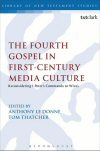
Werner Kelber’s The Oral and the Written Gospel substantially challenged predominant paradigms for understanding early Jesus traditions and the formation of written Gospels. Since that publication, a more precise and complex picture of first-century media culture has emerged. Yet, while issues of orality, aurality, performance, and mnemonics are now well voiced in Synoptic Studies, Johannine scholars remain largely unaware of such issues and their implications. The highly respected contributors to this book seek to fill this lacuna by exploring various applications of orality, literacy, memory, and performance theories to the Johannine Literature in hopes of opening new avenues for future discussion.
Part one surveys the scope of the field by introducing the major themes of ancient media studies and noting their applicability to the Fourth Gospel and the Johannine Epistles. Part two analyzes major themes in the Johannine Literature from a media perspective, and part three features case studies of specific texts. Two responses by Gail O’Day and Barry Schwartz complete the volume.
The contributors to this volume boldly and, in varying measure, successfully demonstrate not just the potential but even the necessity of attending to the media culture(s) in which the Johannine writings first found expression and reception. The issues raised by this volume may focus on the FG and related texts, but they apply more broadly to early Christian and Second-Temple Jewish texts in general. The focus on the Johannine literature gives this collection a coherence and concreteness that clarifies and demonstrates the possibilities of media research. However, the value of this collection for NT and biblical scholarship is in no way limited to students of the FG and its cousins.
—Biblical Theology Bulletin
. . . the volume as a whole represents a significant contribution to conversations surrounding the Fourth Gospel in relation to the first-century media culture.
—Holly E. Hearon, associate professor of New Testament, Christian Theological Seminary, Indianapolis
Anthony Le Donne (PhD, Durham University) is assistant professor of New Testament and Second Temple Judaism at Lincoln Christian University in Illinois. He is the author of The Historiographical Jesus: Memory, Typology, and the Son of David and Historical Jesus: What Can We Know and How Can We Know It?. Together with Jacob Neusner and Bruce Chilton, he co-edited Soundings in Jesus and His Religion.
Tom Thatcher is professor of biblical studies at Cincinnati Christian University. He has authored or edited numerous books and articles on the Johannine literature and early Christian media culture, including Jesus, the Voice, and the Text, Memory, Tradition, and Text, and Why John Wrote a Gospel. A co-founder and former chair of the ‘Mapping Memory’ research group in the Society of Biblical Literature, Tom now serves on the program committee of the SBL’s Bible in Ancient and Modern Media section.
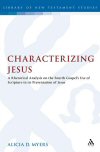
This study explores how the Fourth Gospel’s use of Scripture contributes to its characterization of Jesus. Utilizing literary-rhetorical criticism, Myers approaches the Gospel in its final form, paying particular attention to how Greco-Roman rhetoric can assist in understanding the ways in which Scripture is employed to support the presentation of Jesus. It offers further evidence in favor of the Gospel’s use of rhetoric (particularly synkrisis, ekpharsis, and prosopopoiia), and gives scholars a new way to use rhetoric to better understand the use of Scripture in the Fourth Gospel and the New Testament as a whole.
The book proceeds in three parts. First, it examines ancient Mediterranean practices of narration and characterization in relationship to the Gospel, concluding with an analysis of the Johannine prologue. In the second and third parts, it investigates explicit appeals to Scripture that are made both in and outside of Jesus’ discourses. Through these analyses, Myers contends that the pervasive presence of Scripture in quotations, allusions, and references acts as corroborating evidence supporting the evangelist’s presentation of Jesus.
Alicia D. Myers is assistant professor of New Testament at United Theological Seminary in Dayton, Ohio.
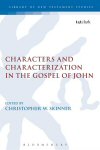
This volume examines characters in the Fourth Gospel and provides an in-depth look at different approaches currently employed by scholars working with literary and reader-oriented methods. Divided into two sections, the book first considers method and theory, followed by exegetical character studies using a literary and reader-oriented method. It summarizes the state of the discussion, examines obstacles to arriving at a comprehensive theory of character in the Fourth Gospel, compares different approaches, and compiles the diverse methodologies into one comparative study. Through this detailed exegesis, the various theories are presented and implemented, and the merits (or deficiencies) of each approach will be available to the reader. This volume is both a comprehensive study in narrative/reader-oriented theories, and a study in the application of those theories as they apply to characterization. Summing up current research on characters and characterization in the Fourth Gospel, this book also provides a comprehensive presentation of different approaches to character that have developed in recent years.
Christopher W. Skinner is assistant professor of religion at Mount Olive College in North Carolina.

Thomas appears only four times in John’s Gospel, yet he is crucially important in understanding the function of the Johannine message. Dennis Sylva provides the first major study which examines the paradox that Thomas is both opposed to a dominant theme in the Fourth Gospel in his disbelief of the resurrection and yet is in support of Jesus himself.
Thomas appears to have a foot on both sides of the Johannine dualistic divide. He seems to be existentially at home on one side and yet ideologically at home on the other. No other character in John’s Gospel so tenaciously holds on to companionship with Jesus while just as resolutely distancing himself from Jesus’ central teaching. Sylva’s new work demonstrates the importance of Thomas in fully understanding the message of the Fourth Gospel.
Dennis Sylva teaches the New Testament at Nashotah House Theological Seminary in Wisconsin.
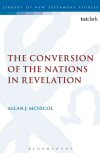
Allan McNicol examines the “Conversion of the nations” in the book of Revelation together with the author’s vision for final redemption. Allan McNicol examines the longstanding tension between the author of Revelation’s description of the destruction of unrepentant nations early in the book in contrast with their final experience of salvation in Rev 21:24–26. McNicol examines how the author of Revelation interprets and refashions both Scripture and the myths of the age in order to lay out his vision of redemption. This leads to his ultimate conclusion that human political power (Rome) will crumble before the influence of the crucified Jesus. Through careful attention to references to the “pilgrimage to the Gentiles” in prophetic literature, McNicol is able to draw valuable conclusions as to how the core tension examined may be resolved. This exegesis is in turn able show how the author of Revelation’s alternative voice to Rome’s power emerged among a small minority community in the Eastern Roman Empire and gained plausibility. This voice not only articulated a construct of its own vindication (thus empowering its own converts), but it also construed a new destiny for the nations themselves separate and apart from Rome.
In this well-written and succinct study, McNichol persuasively argues that on the conversion of the nations, Revelation has a coherent message: the ultimate defeat and conversion of the nations have their place in John’s comprehensive vision of the fortunes and destiny of the Kingdom of God.
—Neotestamentica
Allan J. McNicol is professor of New Testament and faculty chair at the Austin Graduate School of Theology in Austin, Texas.
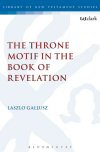
The Throne Motif in the Book of Revelation
- Author: Laszlo Gallusz
- Series: The Library of New Testament Studies (LNTS)
- Publisher: T&T Clark
- Publication Date: 2013
- Pages: 336
The Throne Motif in the Book of Revelation argues that the throne motif constitutes the major interpretive key to the complex structure and theology of the book of Revelation. In the first part of the book, Gallusz examines the throne motif in the Old Testament, Jewish literature, and Graeco-Roman sources. He moves on to devote significant attention to the throne of God texts of Revelation and particularly to the analysis of the throne-room vision in chapters 4 and 5 which is foundational for the development of the throne motif.
Gallusz reveals how Revelation utilizes the throne motif as the central principle for conveying a theological message, since it appears as the focus of the author from the outset to the climax of the drama. The book provides an investigation into the rhetorical impact of the motif and its contribution to the theology of Revelation. Gallusz shows that what the throne actually represents is of critical significance both to Revelation’s theism and to God’s dealing with the problem of evil in the course of human history.
Laszlo Gallusz earned his PhD from Karoli Gaspar University of the Reformed Church in Hungary, Budapest. He is currently a professor of New Testament at Belgrade Theological Seminary in Serbia.
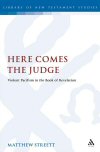
Here Comes the Judge: Violent Pacifism in the Book of Revelation
- Author: Matthew Streett
- Series: The Library of New Testament Studies (LNTS)
- Publisher: T&T Clark
- Publication Date: 2012
- Pages: 296
According to Matthew Streett, the author of Revelation sees violence as perfectly legitimate as long as it is initiated by the appropriate authority—God. The author of Revelation does not believe that violence in any form is wrong. Rather, he believes that it is wrong for anyone other than God or his appointed agents to enact violence, and in his eyes it is possible for humans to condemn the wicked to death if they prove themselves by dying in imitation of Christ.
In this book, Matthew Streett argues that “bridge figures,” such as Jesus Christ, have demonstrated their authority by transitioning from the human realm of the judged to the divine realm of the judge and have earned the right to judge. Initially, only Christ has this right. However, as the narrative progresses, figures such as martyrs are shown to have active, judging authority as well. The challenge for the reader is to understand the Book of Revelation’s sometimes disturbing message on its own terms.
Fr. Matthew Streett earned his PhD in Biblical Studies from The Catholic University of America and is an active duty US Air Force chaplain.
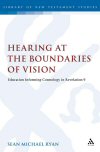
This study considers how a significant variable, namely level of literary education (enkuklios paideia), might affect an ancient hearer’s interpretation of Revelation 9. This volume focuses on how two hypothetical ancient hearer-constructs, with very different “mental libraries,” may interpret the rich cosmological imagery of Revelation 9.
The first is the ancient hearer-construct (HC1), a recipient of minimal literary education, retains a Homeric cosmological model. The second ancient hearer-construct (HC2), by contrast, utilizes a tertiary-level knowledge of Aratus and Plato to allegorically reinterpret the cosmological imagery of Rev 9 (as in Hippolytus, Refutatio IV.46–50). The volume concludes by critically comparing the hypothetical responses of HC1 and HC2 with the early reception of Revelation 9 by Victorinus, Tyconius, and Oecumenius (third to sixth century), attentive to the educational attainment of each commentator.
Sean Michael Ryan is a lecturer in biblical studies at Heythrop College at the University of London.
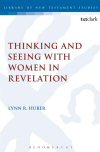
Thinking and Seeing with Women in Revelation
- Author: Lynn R. Huber
- Series: The Library of New Testament Studies (LNTS)
- Publisher: T&T Clark
- Publication Date: 2013
- Pages: 208
Lynn R. Huber argues that the visionary aspect of Revelation, with its use of metaphorical thinking and language, is the crux of the text’s persuasive power. Emerging from a context that employs imagery to promote imperial mythologies, Revelation draws upon a long tradition of using feminine imagery as a tool of persuasion. It does so even while shaping a community identity in contrast to the dominant culture and in exclusive relationship with the Lamb.
By drawing upon the work of medieval and modern visionaries, Huber answers a call to examine the way “real” readers engage with biblical texts. Revealing how Revelation continues to persuade audiences through appeals to the visual and provocative imagery, she offers a new sense of how the text’s metaphorical language simultaneously limits and invites new meaning, unfurling a range of interpretations.
Lynn R. Huber is assistant professor of religious studies at Elon University in North Carolina.
Product Details
- Title: T&T Clark Johannine Studies
- Series: Library of New Testament Studies
- Publisher: T&T Clark
- Volumes: 10
- Pages: 2,600